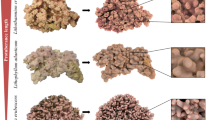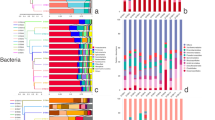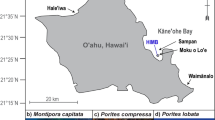Abstract
Rhodoliths are free-living coralline algae (Rhodophyta, Corallinales) that are ecologically important for the functioning of marine environments. They form extensive beds distributed worldwide, providing a habitat and nursery for benthic organisms and space for fisheries, and are an important source of calcium carbonate. The Abrolhos Bank, off eastern Brazil, harbors the world’s largest continuous rhodolith bed (of ∼21 000 km2) and has one of the largest marine CaCO3 deposits (producing 25 megatons of CaCO3 per year). Nevertheless, there is a lack of information about the microbial diversity, photosynthetic potential and ecological interactions within the rhodolith holobiont. Herein, we performed an ecophysiologic and metagenomic analysis of the Abrolhos rhodoliths to understand their microbial composition and functional components. Rhodoliths contained a specific microbiome that displayed a significant enrichment in aerobic ammonia-oxidizing betaproteobacteria and dissimilative sulfate-reducing deltaproteobacteria. We also observed a significant contribution of bacterial guilds (that is, photolithoautotrophs, anaerobic heterotrophs, sulfide oxidizers, anoxygenic phototrophs and methanogens) in the rhodolith metagenome, suggested to have important roles in biomineralization. The increased hits in aromatic compounds, fatty acid and secondary metabolism subsystems hint at an important chemically mediated interaction in which a functional job partition among eukaryal, archaeal and bacterial groups allows the rhodolith holobiont to thrive in the global ocean. High rates of photosynthesis were measured for Abrolhos rhodoliths (52.16 μmol carbon m−2s−1), allowing the entire Abrolhos rhodolith bed to produce 5.65 × 105 tons C per day. This estimate illustrates the great importance of the Abrolhos rhodolith beds for dissolved carbon production in the South Atlantic Ocean.
Similar content being viewed by others
Log in or create a free account to read this content
Gain free access to this article, as well as selected content from this journal and more on nature.com
or
References
Amado-Filho GM, Moura RL, Bastos AC, Salgado LT, Sumida PY, Guth AZ et al. (2012). Rhodolith beds are major CaCO3 bio-factories in the tropical South West Atlantic. PLoS One 7: e35171.
Bahia RG, Abrantes DP, Brasileiro PS, Pereira GH, Amado GM . (2010). Rhodolith bed structure along a depth gradient on the northern coast of Bahia state, Brazil. Braz J Oceanogr 58: 323–337.
Barbera C, Bordehore C, Borg JA, Glemarec M, Grall J, Hall-Spencer JM et al. (2003). Conservation and management of northeast Atlantic and Mediterranean maerl beds. Aquat Conserv 13: S65–S76.
Barott KL, Rodriguez-Brito B, Janouškovec J, Marhaver KL, Smith JE, Keeling P et al. (2011). Microbial diversity associated with four functional groups of benthic reef algae and the reef-building coral Montastraea annularis. Environ Microbiol 13: 1192–1204.
Barott KL, Rohwer FL . (2012). Unseen players shape benthic competition on coral reefs. Trends Microbiol 20: 621–628.
Bastos AC, Moura RL, Amado-Filho GM, D'Agostini DP, Secchin NA, Francini-Filho RB et al. (2013). Buracas: novel and unusual sinkhole-like features in the Abrolhos Bank. Cont Shelf Res (in press).
Beer S, Axelsson L . (2004). Limitations in the use of PAM fluorometry for measuring photosynthetic rates of macroalgae at high irradiances. Eur J Phycol 39: 1–7.
Borowitzka MA . (1987). Calcification in Algae—mechanisms and the role of metabolism. Crit Rev Plant Sci 6: 1–45.
Breitbart M, Hoare A, Nitti A, Siefert J, Haynes M, Dinsdale E et al. (2009). Metagenomic and stable isotopic analyses of modern freshwater microbialites in Cuatro Cienegas, Mexico. Environ Microbiol 11: 16–34.
Burke C, Thomas T, Lewis M, Steinberg P, Kjelleberg S . (2011). Composition, uniqueness and variability of the epiphytic bacterial community of the green alga Ulva australis. ISME J 5: 590–600.
Cavalcanti GS, Gregoracci GB, Longo LL, Bastos AC, Ferreira CM, Francini-Filho RB et al. (2013). Sinkhole-like structures as bioproductivity hotspots in the Abrolhos Bank. Continental Shelf Research (in press).
Dias GTM . (2001). Granulados bioclásticos—algas calcárias. BrazJ Geophys 18: 307–308.
Dupraz C, Visscher PT . (2005). Microbial lithification in marine stromatolites and hypersaline mats. Trens Microbiol 13: 429–438.
Dupraz C, Reid RP, Braissant O, Decho AW, Norman RS, Visscher PT . (2009). Processes of carbonate precipitation in modern microbial mats. Earth-Sci Rev 96: 141–162.
Figueiredo MADO, Menezes KSD, Costa-paiva EM, Paiva PC, Ventura CRR . (2007). Experimental evaluation of rhodoliths as living substrata for infauna at the Abrolhos Bank, Brazil. Cienc Mar 33: 427–440.
Foster MS . (2001). Rodotlihs: between rocks and soft places. J Phycol 37: 659–667.
Garcia GD, Gregoracci GB, de OSE, Meirelles PM, Silva GG, Edwards R et al. (2013). Metagenomic analysis of healthy and white plague-affected Mussismilia braziliensis Corals. Microb Ecol 65: 1076–1086.
Hollants J, Leliaert F, De Clerck O, Willems A . (2012). What we can learn from sushi: a review on seaweed-bacterial associations. Fems Microbiol Ecol 83: 1–16.
Kamenos NA, Moore PG, Hall-Spencer JM . (2004). Maerl grounds provide both refuge and high growth potential for juvenile queen scallops (Aequipecten opercularis L.). Mar Ecol 313: 241–254.
Khodadad CLM, Foster JS . (2012). Metagenomic and metabolic profiling of nonlithifying and lithifying stromatolitic mats of Highborne Cay, The Bahamas. PLoS One, 7.
Krumbein MA, Larkum AWD . (1987). Calcification in algae: mechanisms and the role of metabolism. Crit Rev Plant Sci 6: 1–45.
Liu H, Nolla HA, Campbell L . (1997). Prochlorococcus growth rate and contribution to primary production in the equatorial and subtropical North Pacific Ocean. Aquat Microb Ecol 12: 39–49.
Maxwell K, Johnson GN . (2000). Chlorophyll fluorescence—a practical guide. J Exp Bot 51: 659–668.
Meyer F, Paarmann D, D'Souza M, Olson R, Glass EM, Kubal M et al. (2008). The metagenomics RAST server—a public resource for the automatic phylogenetic and functional analysis of metagenomes. BMC Bioinformatics 9: 386.
Morán XAG, Estrada M, Gasol JM, Pedrós-Alió C . (2002). Dissolved primary production and the strength of phytoplankton- bacterioplankton coupling in contrasting marine regions. Microbial Ecol 44: 217–223.
Nelson WA . (2009). Calcified macroalgae—critical to coastal ecosystems and vulnerable to change: a review. Mar Freshwater Res 60: 787–801.
Ovalle ARC, Rezende CE, Carvalho CEV, Jennerjahn TC, Ittekkot V . (1999). Biogeochemical characteristics of coastal waters adjacent to small river-mangrove systems, East Brazil. Geo-Mar Lett 19: 179–185.
Overbeek R, Begley T, Butler RM, Choudhuri JV, Chuang HY, Cohoon M et al. (2005). The subsystems approach to genome annotation and its use in the project to annotate 1000 genomes. Nucleic Acids Res 33: 5691–5702.
Parks DH, Beiko RG . (2010). Identifying biologically relevant differences between metagenomic communities. Bioinformatics 26: 715–721.
Reshef L, Koren O, Loya Y, Zilber-Rosenberg I, Rosenberg E . (2006). The coral probiotic hypothesis. Environ Microbiol 8: 2068–2073.
Riul P, Lacouth P, Pagliosa PR, Christoffersen ML, Horta PA . (2009). Rhodolith beds at the easternmost extreme of South America: community structure of an endangered environment. Aquat Bot 90: 315–320.
Roberts RD, Kuhl M, Glud RN, Rysgaard S . (2002). Primary production of crustose coralline red algae in a high Arctic fjord. J Phycol 38: 273–283.
Rohwer F, Seguritan V, Azam F, Knowlton N . (2002). Diversity and distribution of coral-associated bacteria. Mar Ecol Prog Ser 243: 1–10.
Rosenberg E, Koren O, Reshef L, Efrony R, Zilber-Rosenberg I . (2007). The role of microorganisms in coral health, disease and evolution. Nat Rev Microbiol 5: 355–362.
Rosenberg E, Zilber-Rosenberg I . (2011). Symbiosis and development: the hologenome concept. Birth Defects Res C Embryo Today 93: 56–66.
Schereiber U, Schiliwa U, Bilger W . (1966). Continuous recording of photochemical and non-photochemical chlorophyll fluorescence quenching with a new type of modulation fluorometer. Photosynth Res 10: 51–62.
Schwarz AM, Hawes I, Andrew N, Mercer S, Cummings V, Thrush S . (2005). Primary production potential of non-geniculate coralline algae at Cape Evans, Ross Sea, Antarctica. Mar Ecol Prog Ser 294: 131–140.
Steller DL, Riosmena-Rodriiguez R, Foster MS, Roberts CA . (2003). Rhodolith bed diversity in the Gulf of California: the importance of rhodolith structure and consequences of disturbance. Aquat Conserv 13: S5–S20.
Visscher PT, Reid RP, Bebout BM, Hoeft SE, Macintyre IG, Thompson JA . (1998). Formation of lithified micritic laminae in modern marine stromatolites (Bahamas): The role of sulfur cycling. Am Mineral 83: 1482–1493.
Wahl M, Goecke F, Labes A, Dobretsov S, Weinberger F . (2012). The second skin: ecological role of epibiotic biofilms on marine organisms. Front Microbiol 3.
Webster NS, Cobb RE, Soo R, Anthony SL, Battershill CN, Whalan S et al. (2011). Bacterial community dynamics in the marine sponge rhopaloeides odorabile under in situ and ex situ cultivation. Mar Biotechnol 13: 296–304.
Whalan S, Webster NS, Negri AP . (2012). Crustose coralline algae and a cnidarian neuropeptide trigger larval settlement in two coral reef sponges. PLoS One 7: e30386.
Wilson S, Blake C, Berges JA, Maggs CA . (2004). Environmental tolerances of free-living coralline algae (maerl): implications for European marine conservation. Biol Conserv 120: 279–289.
Acknowledgements
We acknowledge SISBIOTA CNPq/FAPES, FAPERJ, CNPq and CAPES for funding. We also acknowledge the Project for the International Research Center for Infectious Diseases, Research Institute for Microbial Diseases, Osaka University, from the Ministry of Education, Science, Sports, Culture, and Technology, Japan. FT. Giselle Cavalcanti would like to thank the CNPq for research and PhD fellowships. This paper is part of the DSc requirements for Giselle da Silva Cavalcanti in the Biodiversity and Evolutionary Biology Graduate Program of the Federal University of Rio de Janeiro.
Author information
Authors and Affiliations
Corresponding author
Ethics declarations
Competing interests
The authors declare no conflict of interest.
Additional information
Supplementary Information accompanies this paper on The ISME Journal website
Rights and permissions
About this article
Cite this article
Cavalcanti, G., Gregoracci, G., dos Santos, E. et al. Physiologic and metagenomic attributes of the rhodoliths forming the largest CaCO3 bed in the South Atlantic Ocean. ISME J 8, 52–62 (2014). https://doi.org/10.1038/ismej.2013.133
Received:
Revised:
Accepted:
Published:
Issue date:
DOI: https://doi.org/10.1038/ismej.2013.133
Keywords
This article is cited by
-
Insights on the evolution of the living Great Amazon Reef System, equatorial West Atlantic
Scientific Reports (2019)
-
The microbiome of Codium tomentosum: original state and in the presence of copper
World Journal of Microbiology and Biotechnology (2019)
-
Rhodoliths holobionts in a changing ocean: host-microbes interactions mediate coralline algae resilience under ocean acidification
BMC Genomics (2018)
-
Oyster microbial communities and implications for chalky deposit formation
Hydrobiologia (2018)
-
Eukaryotic Life Inhabits Rhodolith-forming Coralline Algae (Hapalidiales, Rhodophyta), Remarkable Marine Benthic Microhabitats
Scientific Reports (2017)



